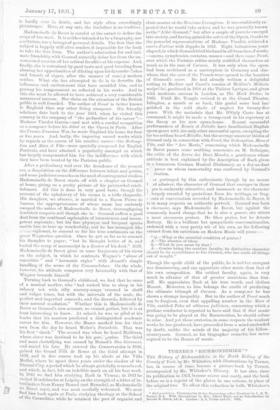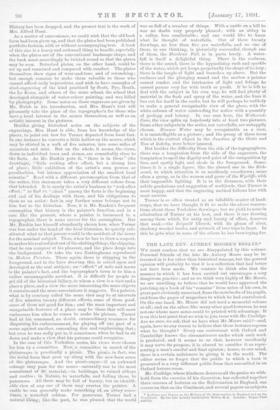TURNER'S " RICIIMONDSHIRE." *
THE History of Richmondshire, in the North Riding of the County of York, by Mr. Whitaker, with illustrations by Turner, has, in course of time, become a picture-book by Turner, accompanied by Mr. Whitaker's History. It has also, since its publication in 1823, become scarce and costly, and the book before us is a reprint of the plates in one volume, in place of the original two. To effect this reduction in bulk, Whitaker's.
* Riclonondshirr. Illustrated by 20 fine Engravings, after Drawings by J. M. W. Turner, R.A. With Descriptions by Mrs. Alfred Hunt, and an Introduction by Marcus B. Huish, LL. B, London : J. B. Virtue and Co. 1891.
History has been dropped, and the present text is the work of Mrs. Alfred Hunt.
As a matter of convenience, we could wish that the old book form had been given up, and that the plates had been published portfolio fashion, with or without accompanying text. A book of this size is a heavy and awkward thing to handle, especially when the plates are of the conventional landscape shape, and the book must accordingly be twisted round so that the plates nay be seen. Detached plates, on the other hand, could be set up and examined and compared with comfort. The plates themselves show signs of wear-and-tear, and of retouching ; but enough remains to make them valuable to those who -cannot afford early impressions, and wish to have examples of steel-engraving of the kind practised by Scott, Pye, Heath, the Le Keux, and others of the same school, the school that -developed alongside of water-colour painting, and was killed by photography. Some notes on those engravers are given by Mr. Huish in his introduction, and Mrs. Hunt's text will pleasantly take the place of the topographer's for those who have a local interest in the scenes themselves, as well as an artistic interest in the pictures.
Besides giving historical notes on the subjects of the -engravings, Mrs. Hunt is able, from her knowledge of the places, to point out how far Turner departed from local fact. In one instance he converts a little hollow on the moors, which may be skirted in a walk of five minutes, into some miles of mountain and mist. But on the whole, it seems, the views, -down to individual trees and stones, are remarkably close to the facts. As Mr. Ruskin puts it, " there is in them" (the drawings), " little seeking after effect, but a strong love of place ; little exhibition of the artist's own powers or \peculiarities, but intense appreciation of the smallest local minutiae." Read with a different preconception from that of the writer, this statement takes a very different colour from that intended. It is surely the artist's business to "seek after .effect; " to find en " effect " among the facts is the beginning and and of his dealings with them, and his obligations to them as an artist : fact in any further sense belongs not to him but to the historian. Now, it is Mr. Ruskin's frequent :assumption that history is the painter's function, and in a case like the present, where a painter is harnessed to a topographer, there is some excuse for the assumption. But Mr. Ruskin has himself abundantly shown how, when Turner was less under the hand of the local historian, he quietly sub- stituted what to that person would be the accident of the scene ,for the nominal subject. Thus, when he has to draw a seaport, lie makes his real subject out of the shifting things, the shipping, that he can compose at his pleasure, and the place drops into the background. Or take the two Nottinghams reproduced in Modern Painters. There again, there is shipping in the foreground, and in the later drawing this is seized upon and developed as the real subject; an " effect" of sails and masts ;is the painter's fact, and the topographer's town is to him a Tether unmanageable accident. It is difficult for people to get rid of the historical fallacy, to whom a view is a view and a place a place, and a view the more interesting the more objects it contains and the more associations it suggests. To a painter, what is by courtesy called the same view may be at intervals of five minutes twenty different effects, some of them good, some of them not good for him ; and the most important and recognisable features of a place may be those that will most -embarrass him when he comes to make his picture. Turner had at his command, no doubt, extraordinary resources for disguising his embarrassment, for playing off one part of a scene against another, concealing this and emphasising that ; but even he was sadly put to it sometimes, when he had to sit down and make a view that his patrons could recognise.
In the case of this Yorkshire series, his views were chosen for him by a committee, Now, a committee in search of the picturesque is practically a picnic. The picnic, in fact, was the social form that grew up along with the new-born sense of the picturesque. And the picnic-esque—if an awkward coinage may pass for the nonce—naturally ran to the most sensational of fit material,—in buildings, to ruined abbeys and castles ; in Nature, to waterfalls, and failing these, to panorama. All these may be full of beauty, but an identifi- able view of any one of them may overtax the painter. A castle he can generally make something of, an abbey some- times, a waterfall seldom. For panorama Turner had a natural liking; like the poet, he was pleased that the world was so full of a number of things. With a castle on a bill he was no doubt very properly pleased ; with an abbey in a valley, less comfortable; and one would like to know what he thought of waterfalls. Out of these twenty drawings, no less than five are waterfalls, and no one of them, to our thinking, is pictorially successful, though one of them, the Hardrau' Fall, is in parts lovely. A water- fall is itself a delightful thing. There is the coolness, there is the sound, there is the hypnotising rush and sparkle of the water, which yet keeps perpetually the shape of its leap ; there is the tangle of light and branches up above. But the coolness and the plunging sound and the motion a painter cannot render, and the intricacies of light and foliage he cannot pursue very far with truth or profit. If he is left to deal with the subject in. his own way, ho will find plenty of material in the flash and spray of the water, and the lines it has cut for itself in the rocks, but he will perhaps be unlikely to make a general recognisable view of the place, with the white column of water contending for notice with a quantity of geology and botany. In one case here, the Wethercote Cave, the view splits up hopelessly into at least two pictures. Some other subjects in the series, not waterfalls, are unhappily chosen. Simmer Water may be recognisable as a view, it is unintelligible as a picture ; and the group of three trees which is the central object in the junctioa of the Greta and Tees at Roleeby, were better ignored.
But besides the difficulty from the side of the topographers, there was a temptation from the side of the engravers, the temptation to spoil the dignity and quiet of the composition by fuss, and spotty light and shade in the foreground. Some- times it is a single figure, like the absurd one in the Rich- mond, to which attention is so needlessly overdrawn ; more often a group, as in the women and geese of the Wye/afe, with their impossible lighting. It is in the distances, with their subtle gradations and suggestion of multitude, that Turner is most happy, and that the engraving method follows him with most success.
Turner is so often treated as an infallible master of land- scape, that we have thought it fit to make the above reserva- tions about these Yorkshire drawings; but we yield to none in admiration of Turner at his best, and there is one drawing among them which, for unity and beauty of effect, deserves that rank,—the Brignall Church, with its . gleam of river, shadowy wooded banks, and network of tree-tops in front. In this he gets what in some of the others he has been trying for.







































 Previous page
Previous page